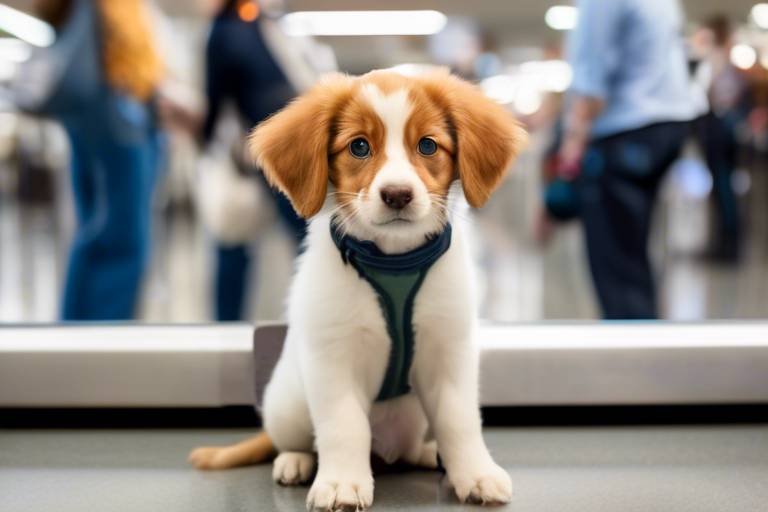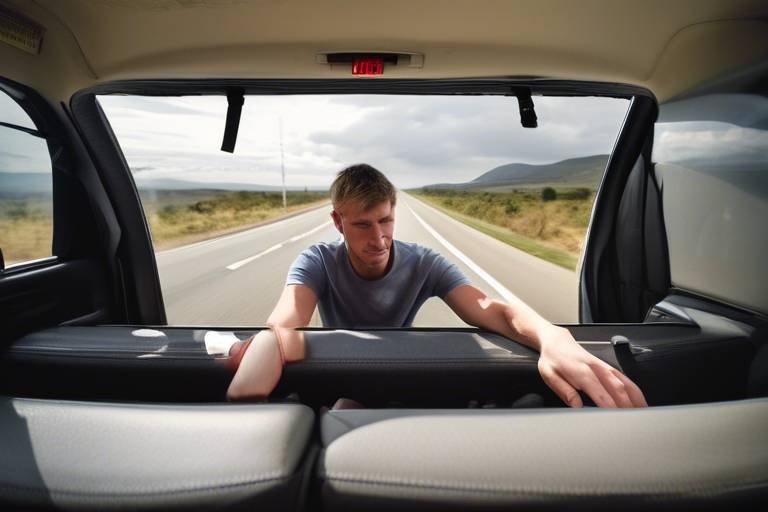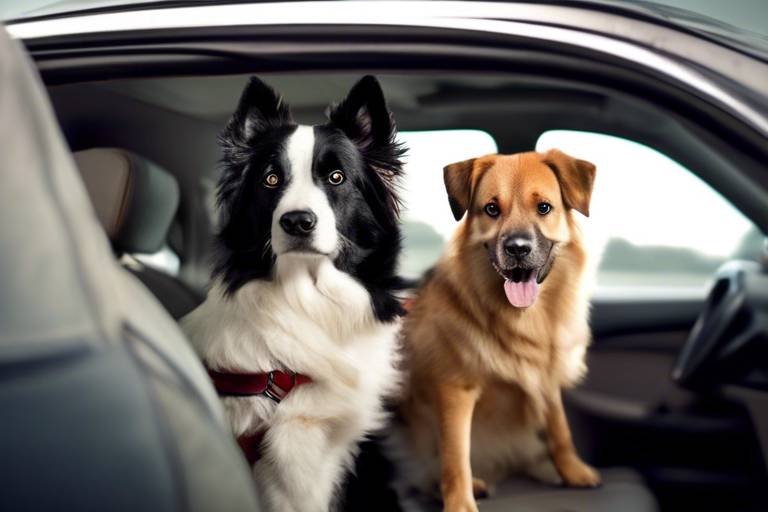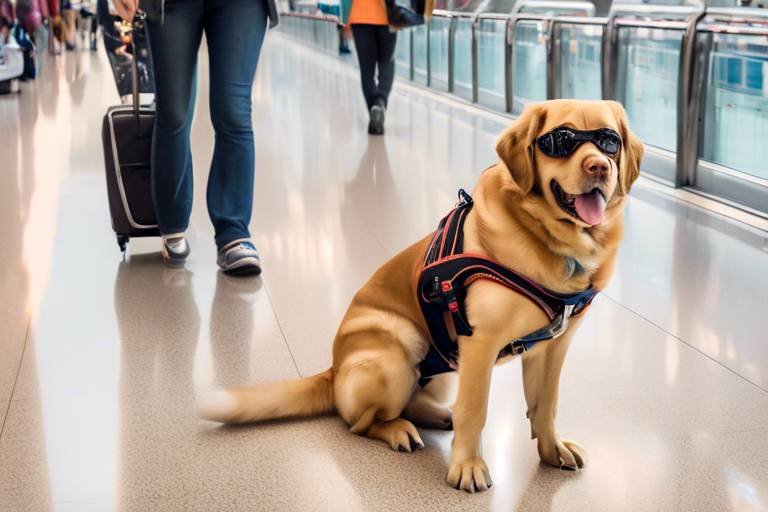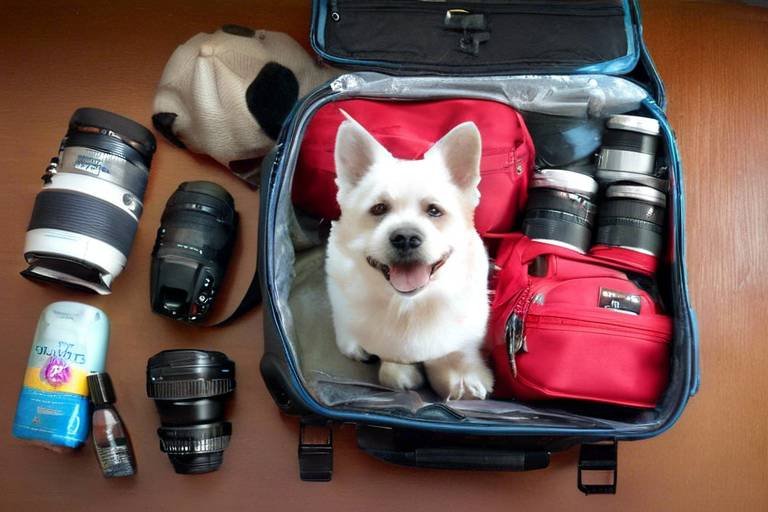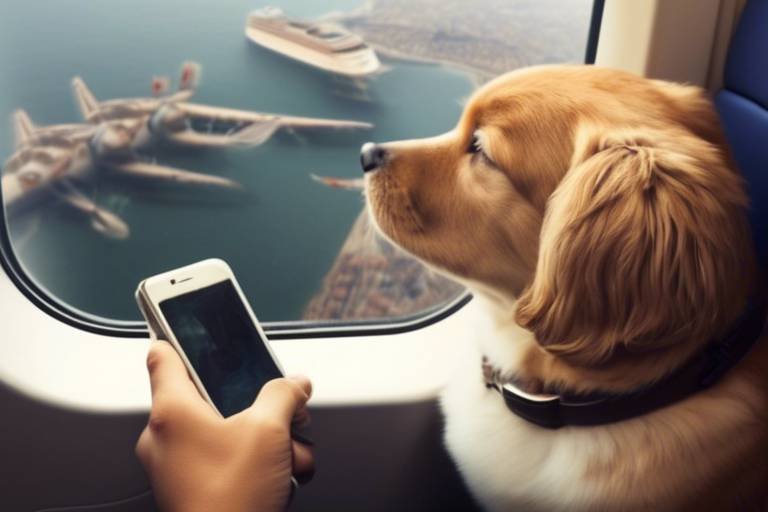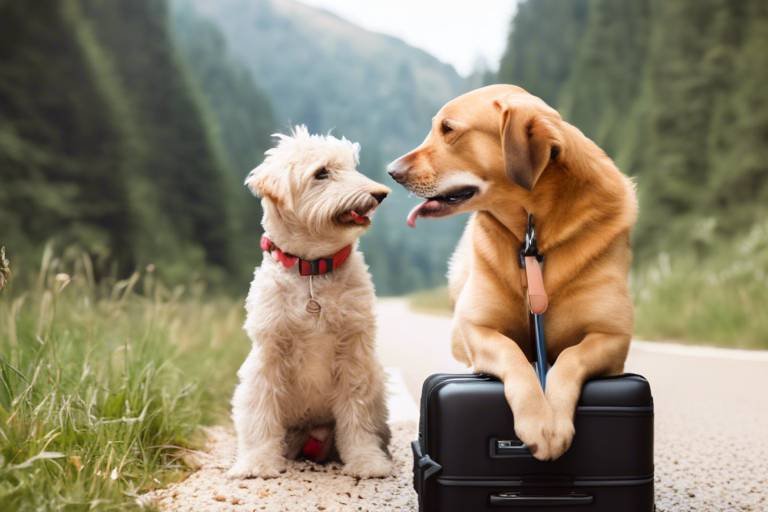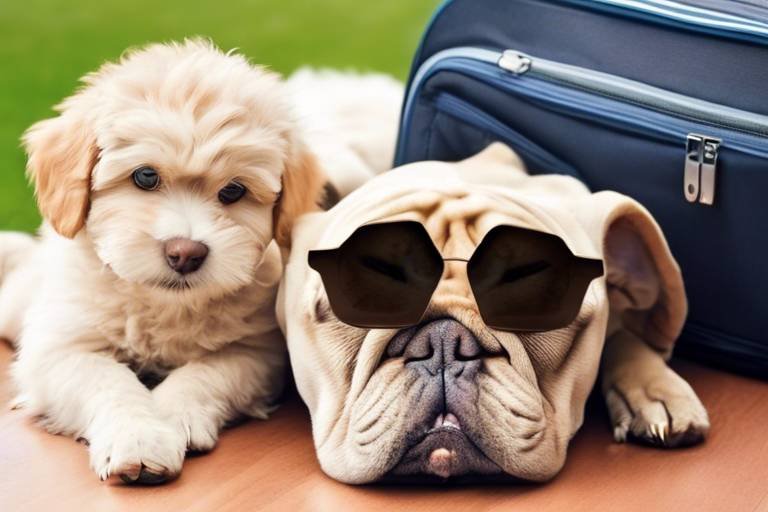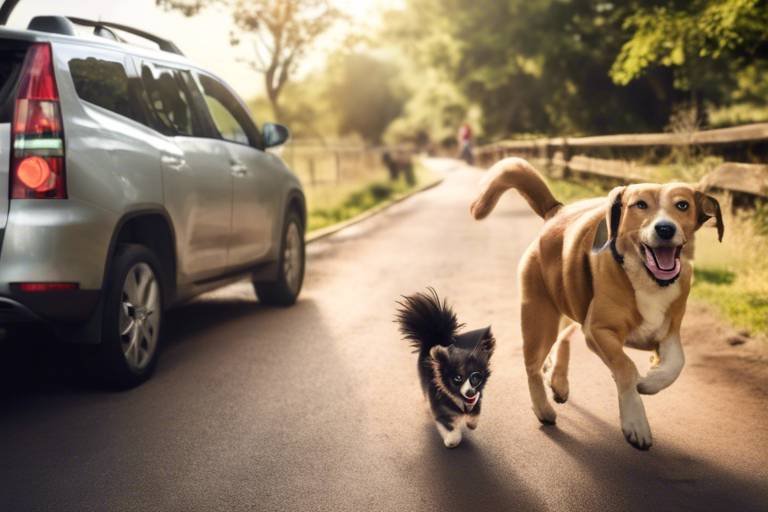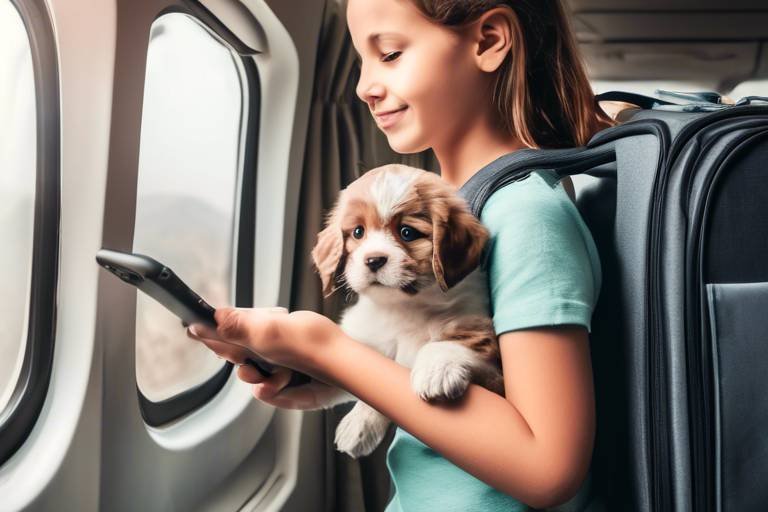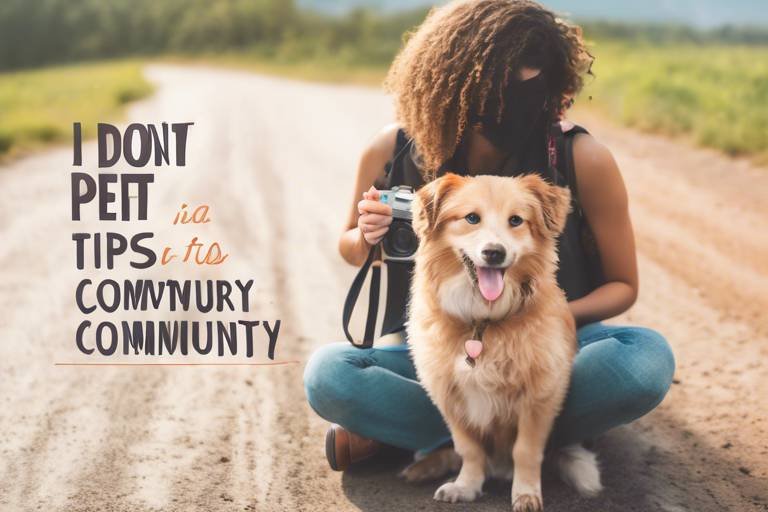Tips for Navigating Local Customs with Pets
Traveling with your furry friend can be one of the most rewarding experiences, but it also comes with its own set of challenges. Whether you're planning a weekend getaway or an extended vacation, understanding local customs is essential for ensuring a smooth journey. Imagine this: you arrive at a beautiful destination, only to be met with puzzled looks from locals because your pet is not following the local etiquette. Yikes! To avoid such awkward moments, here are some crucial tips to help you navigate the complexities of traveling with pets while respecting local customs.
Familiarizing yourself with local pet laws is crucial when traveling. Regulations can vary significantly, impacting everything from leash laws to breed restrictions. For instance, in some cities, specific breeds may be banned, while others may require pets to be on a leash at all times. By doing a little homework before your trip, you can ensure a smooth experience for both you and your pet. Here are a few things to consider:
- Check leash laws: Some places may have stricter leash requirements than others.
- Research breed restrictions: Certain breeds may face bans in specific areas.
- Understand pet licensing: Some locations may require pets to be licensed or registered.
Finding pet-friendly accommodations can significantly enhance your travel experience. Imagine arriving at a hotel that not only welcomes your pet but also has special amenities just for them! To identify hotels, rentals, or campsites that welcome pets, consider the following:
- Use pet-friendly travel websites and apps.
- Read reviews from other pet owners.
- Contact the accommodation directly to ask about their pet policies.
Ensuring a comfortable stay is essential, so look for places that offer pet beds, food bowls, and even dog parks nearby. After all, a happy pet means a happy owner!
Different cultures have varying attitudes towards pets. In some countries, pets are considered part of the family, while in others, they may be viewed more as outdoor companions. Understanding these perspectives can help you navigate social situations and avoid misunderstandings while traveling with your pet. For example, in some cultures, it might be considered rude to allow your dog to approach strangers without permission. Being aware of these nuances can make your travels much more enjoyable.
Preparation is key when traveling with pets. Before you hit the road or board a plane, make sure your furry friend is ready for the journey. This includes scheduling health checks, ensuring vaccinations are up to date, and packing necessary supplies. Here’s a quick checklist:
- Visit the vet for a health check-up.
- Update vaccinations and obtain any required documentation.
- Pack food, water, bowls, and any favorite toys for comfort.
Taking these steps can help ensure your pet's comfort and safety during your travels.
Air travel can be challenging for pets, but with the right preparation, you can make it a stress-free experience. When booking flights, check the airline's pet policy, as they can vary widely. Some airlines may allow pets in the cabin, while others may require them to travel in cargo. Make sure to:
- Choose a direct flight whenever possible.
- Get an airline-approved pet carrier.
- Prepare your pet for the experience by taking them on short car trips beforehand.
Ensuring they are comfortable during transit is crucial, so consider bringing familiar items to help ease their anxiety.
Understanding local pet etiquette is vital for harmonious interactions. For instance, some places may have specific leash requirements or pet behavior expectations. When approaching local pet owners, always ask if it's okay for your pet to interact with theirs. This simple gesture can go a long way in fostering good relationships and avoiding potential conflicts.
Being prepared for emergencies while traveling is essential. Create a pet emergency plan that includes locating nearby vets and understanding local emergency protocols. It’s a good idea to have a list of veterinary clinics and emergency pet hospitals saved on your phone. Knowing where to go in case of an emergency can provide peace of mind during your travels.
Connecting with local pet communities can enhance your travel experience. Look for pet meetups, parks, and events that allow you to socialize and share experiences with other pet owners. This can be a great way to discover pet-friendly places and activities in the area. Plus, your pet will love making new friends!
After your travels, it’s important to help your pet readjust. Monitor their health closely and re-establish routines to help them feel secure again. Some pets may experience anxiety or behavioral changes after a trip, so be patient and give them the love and attention they need to settle back in.
Q: What should I do if my pet gets sick while traveling?
A: Always have a list of local veterinarians and emergency clinics handy. If your pet shows signs of illness, seek veterinary care as soon as possible.
Q: Are there any specific travel tips for flying with pets?
A: Yes! Always check the airline's pet policy, use an approved carrier, and consider booking direct flights to minimize stress for your pet.
Q: How can I find pet-friendly activities at my destination?
A: Research local pet meetups, parks, and pet-friendly events online. Social media groups can also be helpful for finding local pet communities.

Understanding Local Pet Laws
When you're planning to travel with your furry companion, understanding local pet laws is absolutely crucial. Imagine arriving at a beautiful destination, only to find out that your beloved pet is not welcome in certain public areas or that there are strict leash laws you were unaware of. This can turn a fun trip into a stressful situation, and nobody wants that! Each location has its own set of regulations, which can vary significantly from what you're used to back home. For instance, some cities may have breed restrictions, meaning certain breeds may not be allowed at all. This can be particularly surprising if you're traveling with a breed that is common and accepted in your area but frowned upon elsewhere.
To avoid any unpleasant surprises, it's wise to do your homework before you set off. Start by checking local government websites or pet travel resources that outline the specific laws in your destination. You might find information on:
- Leash laws: Some places require pets to be leashed at all times, while others may have designated off-leash areas.
- Breed restrictions: Certain breeds may be banned or require special permits to enter specific areas.
- Pet registration: Some cities may require pets to be registered with local authorities.
- Vaccination requirements: Ensure your pet’s vaccinations are up to date, as some areas may require proof of vaccination.
Additionally, it’s beneficial to familiarize yourself with local pet ordinances. For example, some places might have noise ordinances that could affect pets, especially if your dog is prone to barking. Understanding these regulations not only helps you avoid fines or penalties but also ensures a more enjoyable experience for you and your pet. It's like learning the rules of a game before you play; it allows you to strategize and enjoy the fun without the risk of penalties!
Finally, don't hesitate to reach out to local pet owners or pet-related businesses in your destination. They can provide valuable insights into the unwritten rules and expectations regarding pet ownership in that area. Engaging with the local community can make your travel experience richer and more enjoyable. So, before you hit the road or take to the skies, take a little time to ensure you and your pet are well-prepared to navigate the local laws and customs. After all, a well-informed traveler is a happy traveler!

Researching Pet-Friendly Accommodations
When it comes to traveling with your furry companion, finding the right place to stay can make all the difference. Imagine arriving at your destination, only to discover that your hotel has a strict no-pet policy. Yikes! That's why doing your homework on pet-friendly accommodations is essential. Not only does it ensure a stress-free trip for you, but it also guarantees your pet feels welcomed and comfortable.
First things first, you want to start your search early. Many popular travel sites now have filters that allow you to specifically look for pet-friendly options. This can include hotels, vacation rentals, and even campsites. Websites like PetsWelcome or Airbnb can be a goldmine for pet owners. They provide detailed information on pet policies, including size restrictions, additional fees, and even the number of pets allowed. Always read the fine print, as some places may have specific requirements that could catch you off guard.
Another crucial aspect to consider is the amenities offered for your pet. Does the hotel provide dog beds, bowls, or even a pet-friendly menu? Some accommodations go above and beyond, offering dog parks, walking trails, or even pet-sitting services. These little extras can enhance your stay and make your pet feel more at home. For example, a hotel that offers a designated pet area can be a lifesaver for those late-night bathroom breaks!
Location also plays a significant role in your choice of accommodation. Look for places that are near parks or pet-friendly attractions. This way, you can easily take your pet out for a stroll or a play session without having to drive too far. Plus, it can be a great way to meet other pet owners and socialize, both for you and your furry friend!
Don't hesitate to reach out directly to the accommodation. A quick phone call can clarify any uncertainties and give you a feel for how pet-friendly they really are. Ask about their pet policies, fees, and what they provide for pets. Sometimes, speaking to a real person can reveal hidden gems or special deals that you might not find online.
Lastly, consider reading reviews from other pet owners. Websites like TripAdvisor often have sections where travelers share their experiences with pets. Look for comments on the staff's attitude towards pets, cleanliness, and how accommodating they were. This firsthand information can be invaluable in making your decision.
Here's a quick summary of what to look for when researching pet-friendly accommodations:
| Criteria | Details |
|---|---|
| Pet Policy | Size restrictions, number of pets allowed, additional fees |
| Amenities | Dog beds, bowls, pet-friendly menus, walking areas |
| Location | Proximity to parks, pet-friendly attractions |
| Reviews | Feedback from other pet owners |
By taking the time to research your options and considering these factors, you can ensure that both you and your pet enjoy a fantastic getaway. After all, a happy pet makes for a happy trip!

Respecting Cultural Attitudes Towards Pets
When you embark on a journey with your furry friend, it's essential to recognize that not every destination shares the same cultural attitudes towards pets. In some places, pets are viewed as beloved family members, while in others, they might be seen more as working animals or even nuisances. This disparity can greatly influence how you and your pet are perceived, and understanding these nuances can make your travels smoother and more enjoyable.
For instance, in countries like France and Italy, dogs are often treated like royalty. You’ll find them lounging in cafés, accompanying their owners on shopping trips, and even being pampered at dog spas. However, in other regions, such as parts of Asia, pets may not have the same status, and local customs might dictate a more reserved approach to their presence in public spaces.
Here are some key points to consider when navigating cultural attitudes:
- Observe Local Norms: Before diving into a new culture, take a moment to observe how locals interact with their pets. Are dogs allowed in shops? Do people pick up after their pets? These small details can provide valuable insights.
- Ask Questions: Don’t hesitate to inquire about local customs regarding pets. Locals can offer advice on where pets are welcome and what behaviors are expected.
- Be Mindful of Leash Laws: In some areas, leash laws may be strictly enforced. Always check local regulations to avoid any potential fines or misunderstandings.
Additionally, it’s crucial to recognize that certain breeds may be viewed differently in various cultures. For example, a breed considered friendly in one country might be seen as intimidating in another. This perception can affect how you and your pet are treated, so it’s wise to research breed-specific attitudes in your destination.
Furthermore, social interactions can vary significantly. In some cultures, it’s perfectly acceptable to approach a stranger with a pet, while in others, it might be seen as intrusive. Always gauge the situation and respect personal space. If a local seems hesitant to engage with your pet, it’s best to give them some distance.
In summary, being aware of and respecting cultural attitudes towards pets not only enriches your travel experience but also fosters goodwill between you and the locals. By adapting to these customs, you’ll ensure that your journey is filled with positive interactions, making it a memorable adventure for both you and your furry companion.
Q: How can I find out about local pet customs before traveling?
A: Research online forums, travel blogs, or social media groups dedicated to pet travel. Websites like BringFido or PetTravel can also provide valuable insights.
Q: What should I do if my pet is not welcomed in a certain area?
A: Always have a backup plan. Look for pet-friendly parks or areas where your pet can stretch their legs without causing any disruption.
Q: Are there any breeds that might face restrictions in certain countries?
A: Yes, some countries have breed-specific legislation that may restrict or ban certain breeds. Always check local laws before traveling.

Preparing Your Pet for Travel
When it comes to traveling with your furry friend, preparation is not just a good idea—it's essential! Imagine embarking on an adventure without packing your essentials; it would be chaotic, right? The same applies to your pet. Ensuring your pet is ready for travel can make all the difference in having a smooth and enjoyable experience. Start by scheduling a visit to the veterinarian. A thorough health check is crucial, especially if your pet hasn’t traveled before. This visit ensures that your pet is fit to travel and up to date on vaccinations, which can be a requirement in many destinations.
Next, consider your pet’s comfort during the journey. Just like humans, pets can experience anxiety when faced with new environments. To ease this, pack a travel bag for your pet that includes their favorite blanket or toy. This familiar scent can help calm them down. Don’t forget to include essential supplies like food, water, bowls, and any medications your pet might need. You wouldn’t want to be caught in a situation where your pet needs their medication, and you don’t have it!
Also, think about the mode of transportation you’ll be using. If you’re flying, check the airline’s pet policy well in advance. Each airline has different regulations regarding pet travel, including crate specifications and fees. Make sure to have the appropriate carrier that is well-ventilated and spacious enough for your pet to stand, turn around, and lie down comfortably. If you’re traveling by car, take frequent breaks to allow your pet to stretch their legs and relieve themselves. It’s not just about getting to your destination; it’s about the journey there!
To ensure your pet is ready for the trip, consider taking them on short car rides leading up to your travel date. This can help them get accustomed to being in a vehicle. If you’re flying, you might want to simulate the experience of being in a carrier by allowing them to spend time in it at home. This way, they’ll feel less anxious when the actual travel day arrives.
Lastly, don’t forget to update your pet’s identification tags. Ensure they have a collar with a tag that includes your current contact information. It’s a simple yet effective way to ensure your pet’s safety in case they get lost during your travels. If your pet is microchipped, double-check that the information is up to date as well.
By taking these steps, you’ll be setting the stage for a successful trip with your beloved pet. Remember, preparation is key, and a little effort can go a long way in ensuring that both you and your pet have a fantastic travel experience!
- What vaccinations does my pet need before traveling? It's essential to check with your veterinarian about the specific vaccinations required for the destination you're traveling to. Common ones include rabies and distemper.
- How can I help my pet adjust to travel? Gradual exposure to travel by taking short trips can help your pet get used to being in a car or carrier.
- What should I do if my pet gets anxious during travel? Consider consulting your vet about anxiety-reducing medications or natural remedies that can help calm your pet.
- Are there any pet travel insurance options? Yes, many insurance companies offer travel insurance that includes coverage for pets. It’s worth looking into for peace of mind.

Traveling by Air with Pets
Traveling by air with your furry companions can be both exciting and nerve-wracking. Imagine the thrill of embarking on a new adventure, but then picture the anxiety of ensuring your pet is comfortable and safe during the journey. The key to a smooth flight lies in preparation and understanding the airline's pet policies. First and foremost, check with your airline about their specific rules regarding pet travel. Some airlines allow pets in the cabin, while others may require them to be transported in the cargo hold. Each option comes with its own set of guidelines and fees, so it’s essential to read the fine print.
Before booking your flight, consider your pet's size and temperament. Smaller pets often have the advantage of flying in the cabin, nestled in a well-ventilated carrier under your seat. This can be a comforting experience for both you and your pet. On the other hand, larger breeds may need to fly in cargo, which can be a more stressful environment. To ease your pet's anxiety, familiarize them with their carrier ahead of time. Make it a cozy space by adding their favorite blanket or toy, which can help them feel more secure during the flight.
Another crucial aspect is timing your travel. Try to avoid peak travel seasons when airports are bustling, as this can add unnecessary stress. Opt for early morning or late evening flights, which are typically less crowded. Additionally, ensure that your pet is well-fed but not overly full before the journey. A light meal a few hours before departure can help prevent motion sickness while still keeping them comfortable.
When you arrive at the airport, allow yourself ample time for check-in and security procedures. Make sure your pet is secured in their carrier, and be prepared to show any required documentation, such as health certificates or vaccination records. Some airlines might even require a specific pet travel form, so having all your paperwork organized can save you from last-minute panic.
During the flight, keep an eye on your pet's behavior. If they seem restless or anxious, speaking softly to them can help soothe their nerves. If your pet is traveling in the cabin, you might also want to bring some treats or toys to keep them occupied. However, avoid giving them too much food or water during the flight to prevent any accidents.
Finally, once you land, give your pet some time to adjust to the new environment. Take them for a walk to stretch their legs and relieve themselves. Remember, flying can be a disorienting experience for pets, so be patient as they acclimate to their surroundings.
In summary, air travel with pets requires careful planning and consideration. By understanding the airline's policies, preparing your pet, and remaining calm during the journey, you can ensure a pleasant experience for both you and your furry friend. After all, the goal is to arrive at your destination ready to explore and create lasting memories together!

Local Pet Etiquette
When you’re traveling with your furry companion, understanding is essential for ensuring a smooth and enjoyable experience. Just like learning the local language can help you navigate a new country, grasping the cultural norms surrounding pets can make a world of difference. Imagine this: you’re strolling through a quaint village, and you notice locals giving you the side-eye because your dog is off-leash. That’s a clear signal that you might be stepping on some cultural toes!
Different regions have unique expectations regarding pet behavior, and being aware of these can help you avoid awkward situations. For example, in some places, it’s customary to keep your dog on a leash at all times, while in others, you might find that dogs are allowed to roam freely in designated areas. Understanding these nuances not only shows respect for the local customs but also contributes to a harmonious relationship between pet owners and the community.
Here are a few key points to consider when it comes to local pet etiquette:
- Leash Laws: Always check the local regulations regarding leash laws. Some cities have strict leash laws, while others may allow off-leash areas. Ignoring these rules can lead to hefty fines and, more importantly, upset locals.
- Pet Behavior: Be mindful of your pet's behavior. Not all dogs are social butterflies, and some may react negatively to unfamiliar animals or people. Keep your pet calm and under control to avoid any mishaps.
- Cleaning Up: Always carry waste bags and clean up after your pet. This not only keeps the area clean but also shows respect for the community. Nobody wants to step in a mess, right?
- Greeting Etiquette: When meeting other pet owners, ask if it's okay to let your pets interact. Not everyone is comfortable with this, and respecting their wishes is key.
Additionally, if you find yourself in a pet-friendly establishment, such as a café or a park, be sure to observe how locals interact with their pets. You might discover that some places have specific areas for pets or even certain times when pets are allowed. This can enhance your experience and help you blend in with the local crowd.
Lastly, consider engaging with local pet communities. This can be an excellent way to learn about the area’s pet etiquette firsthand. Many towns have social media groups or meetups where pet owners gather to share tips, experiences, and even fun activities. It’s a great opportunity to connect with fellow pet lovers and immerse yourself in the local culture.
In conclusion, being aware of local pet etiquette is not just about following rules; it’s about fostering good relationships and creating a positive atmosphere for everyone involved. So, the next time you pack your bags for a pet-friendly adventure, remember to do a little homework on the local customs. Your furry friend will thank you for it!
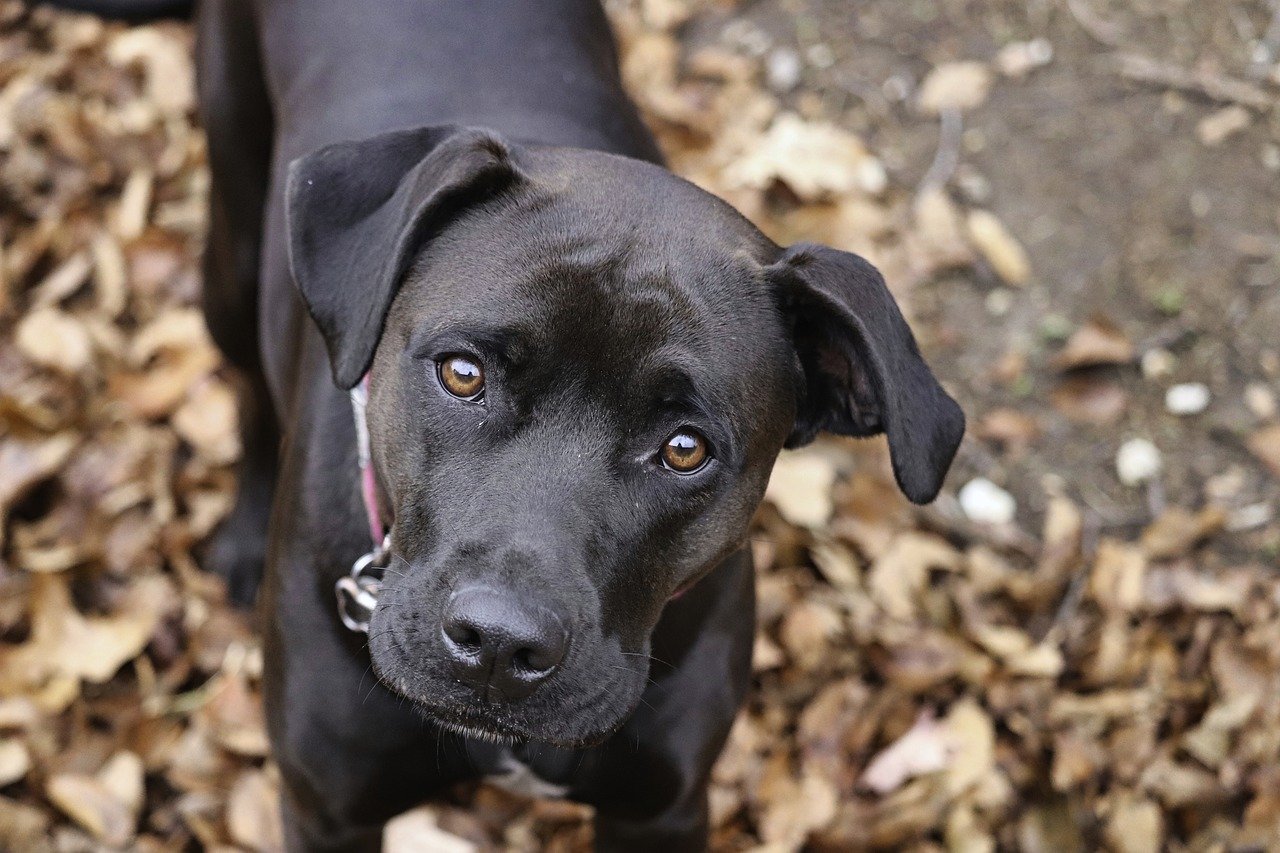
Emergency Preparedness for Pets
Traveling with your furry friend can be an exhilarating adventure, but it's crucial to be prepared for any unexpected situations that may arise. Just like you wouldn't head out on a road trip without a spare tire, you shouldn't travel with your pet without an emergency plan. The first step in emergency preparedness is to know the location of nearby veterinary clinics at your destination. A quick online search can help you compile a list of vets, along with their contact information and hours of operation. You might even consider saving this information on your phone for easy access.
Another essential aspect of preparedness is understanding local emergency protocols. Different places may have varying procedures, so it's wise to familiarize yourself with the local laws regarding pets in emergencies. For instance, some areas may have specific rules about evacuating with pets during natural disasters. This knowledge can save you precious time and stress in critical situations.
Don't forget to pack a pet emergency kit! This kit should include:
- First Aid Supplies: Bandages, antiseptic wipes, and any medications your pet may need.
- Food and Water: Enough for at least three days, along with bowls.
- Identification: Ensure your pet has a collar with an ID tag and consider microchipping for added security.
- Comfort Items: Bring along a favorite toy or blanket to help soothe your pet in unfamiliar surroundings.
In addition to the physical preparations, it's important to mentally prepare your pet for travel. Familiarize them with their carrier or travel crate ahead of time to help reduce anxiety. You might even take them on short car rides to get them used to the motion and sounds of travel. Remember, a calm pet is a happy pet!
Lastly, consider creating a pet emergency plan that includes your pet's specific needs. This plan should outline how to handle various scenarios, such as losing your pet or dealing with a sudden illness. Share this plan with anyone who might be caring for your pet during your travels, ensuring everyone is on the same page.
What should I include in my pet emergency kit?
Your pet emergency kit should include first aid supplies, food and water, identification tags, and comfort items like toys or blankets.
How can I find a vet in an unfamiliar area?
A quick online search or using pet-specific apps can help you locate nearby veterinary clinics, along with their contact details and reviews.
What should I do if my pet gets lost while traveling?
Immediately start searching the area, notify local animal shelters, and post on social media. Having your pet microchipped can significantly increase the chances of a safe return.

Engaging with Local Pet Communities
When you travel with your furry friend, one of the most rewarding experiences can be engaging with local pet communities. Imagine walking through a new town and stumbling upon a local dog park where tails are wagging and new friendships are being formed! Not only does this give your pet a chance to socialize, but it also allows you to connect with fellow pet lovers who can provide valuable insights about the area.
To dive into these communities, start by doing a bit of research before your trip. Social media platforms and local forums can be treasure troves of information. Look for groups dedicated to pets in the area you’re visiting. These groups often share tips on the best parks, pet-friendly cafes, and even upcoming events where you can meet other pet owners. Don’t be shy! Engaging with these communities can lead to fantastic recommendations and perhaps even a few new friends.
When you arrive at your destination, consider visiting local pet shops or veterinary clinics. These places often have bulletin boards filled with information about community events, pet meetups, and local pet services. You might find that there’s a dog-friendly event happening right around the corner! Additionally, many cities have pet-centric events such as dog parades or charity walks, which can be a fun way to spend your day while giving back to the community.
Another great way to immerse yourself in the local pet culture is by visiting dog parks. Not only do these parks provide a safe space for your pet to play, but they also serve as social hubs for pet owners. You can engage in conversations, share experiences, and even get tips about the best local pet-friendly spots. Just remember to respect the park's rules and be mindful of the local etiquette, as each community may have its own unwritten guidelines.
For those who enjoy a more structured approach, consider participating in local pet classes or workshops. Many communities offer training sessions or fun activities like agility courses that you and your pet can enjoy together. These classes not only help strengthen the bond between you and your pet but also allow you to meet like-minded individuals who share your passion for pets.
Lastly, don’t forget to document your experiences! Sharing your adventures on social media or pet blogs can inspire others to engage with local pet communities. Plus, it’s a great way to keep memories alive, showcasing the joy and excitement of traveling with your furry companion. So, as you embark on your next journey, remember that the world is full of pet lovers waiting to connect!
Q: How can I find local pet communities while traveling?
A: You can find local pet communities by searching on social media platforms, checking local forums, or visiting pet shops and veterinary clinics for information on events and meetups.
Q: Are there any specific events I should look for in pet communities?
A: Look for dog-friendly events such as parades, charity walks, and training classes, which can be great opportunities to meet other pet owners and engage with the community.
Q: What should I keep in mind when visiting local dog parks?
A: Always respect the park's rules, be aware of the local etiquette, and ensure your pet is well-behaved to maintain a positive environment for everyone.

Returning Home After Travel
After an exciting adventure with your furry friend, returning home can be a bittersweet experience. You’re back in familiar surroundings, but your pet may need a little extra care to readjust. Just like humans, pets can experience a range of emotions after travel, from excitement to anxiety. So, what can you do to make this transition smoother for your beloved companion? Let’s dive into some essential tips and tricks to help your pet feel at home again.
First and foremost, it’s important to monitor your pet’s health after returning from your travels. Have they been eating well? Are they acting normally? Sometimes, the stress of travel can lead to changes in appetite or behavior. Keep an eye out for signs of stress or illness, and don’t hesitate to consult your veterinarian if something seems off. Remember, your pet relies on you to keep them safe and healthy!
Next, re-establishing routines is crucial. Pets thrive on consistency. If you’ve been away for a while, your pet may be used to a different schedule. Try to resume their regular feeding times, walks, and play sessions as soon as possible. This not only helps them feel secure but also reinforces their understanding of home as a safe space. Think of it like coming back to a cozy, familiar blanket after a chilly day—comforting and reassuring.
Additionally, consider giving your pet some extra love and attention during this transition period. They may be feeling a bit insecure or confused after the trip. Spend quality time with them, whether it’s through cuddles, playtime, or just being present. A little extra affection can go a long way in helping them feel grounded again.
It’s also a good idea to check for any lingering travel-related items that might need to be unpacked or cleaned. For example, if you brought back any pet supplies, toys, or new bedding, make sure to integrate these into your home environment. However, be cautious with new items—sometimes pets can be wary of unfamiliar objects. Introduce them slowly, allowing your pet to explore at their own pace.
Lastly, don’t forget about the importance of socialization. If your pet has been away from their usual playmates, they might feel a little out of touch. Arrange playdates or visits to the local dog park to help them reconnect with their friends. This not only helps your pet socialize but can also alleviate any lingering anxiety from the travel experience. It’s like throwing a little reunion party for your furry buddy!
In summary, returning home after travel is an opportunity to reconnect with your pet and ensure they feel safe and loved. By monitoring their health, re-establishing routines, providing extra affection, integrating new items carefully, and encouraging socialization, you can help your pet transition back to their home life with ease. Remember, every pet is unique, so be patient and attentive to their needs during this time.
- How long does it take for a pet to adjust after travel? - Every pet is different; some may readjust within a few days, while others might take a couple of weeks. Monitor their behavior closely.
- Should I change my pet's diet after travel? - If your pet has been eating differently while away, gradually transition them back to their regular diet to avoid stomach upset.
- What signs should I look for to know if my pet is stressed? - Signs include excessive barking, hiding, changes in appetite, or destructive behavior. If you notice these, provide extra comfort and consult your vet if necessary.
Frequently Asked Questions
- What are the most important local pet laws I should know before traveling?
Before you embark on your journey, it's crucial to research the local pet laws of your destination. These laws can vary widely and may include leash requirements, breed restrictions, and even regulations on where pets are allowed. Familiarizing yourself with these rules can save you from unexpected fines or complications during your trip.
- How can I find pet-friendly accommodations?
Finding a place that welcomes your furry friend can enhance your travel experience immensely. Websites like Airbnb, Booking.com, and dedicated pet travel sites allow you to filter accommodations that are pet-friendly. Always check reviews and confirm with the host about their pet policy to ensure a comfortable stay for both you and your pet.
- What should I do to prepare my pet for travel?
Preparation is key! Start by scheduling a health check with your vet to ensure your pet is fit for travel. Make sure vaccinations are up to date, and pack a travel bag that includes food, water, bowls, medications, and comfort items like toys or blankets. The more prepared you are, the smoother your trip will be.
- Are there specific tips for flying with pets?
Absolutely! When flying, always check the airline's pet policy as they vary. Book a direct flight if possible to minimize stress. Use a well-ventilated, comfortable carrier that your pet is familiar with, and consider a pre-flight trial run to get them used to it. Don’t forget to keep their comfort in mind throughout the journey!
- What is local pet etiquette?
Understanding local pet etiquette can make your travels much more enjoyable. This includes knowing leash laws, picking up after your pet, and respecting other people's space. If you see local pet owners, a friendly greeting goes a long way, but always ask before approaching their pets.
- How can I prepare for pet emergencies while traveling?
Being prepared for emergencies is vital. Create a pet emergency plan that includes locating nearby veterinary clinics and understanding local emergency protocols. Keep a pet first-aid kit handy and ensure you have all necessary contact information saved on your phone for quick access.
- How can I connect with local pet communities during my travels?
Engaging with local pet communities can enrich your experience. Look for pet meetups, local parks, or events through social media or community boards. Apps like Meetup can help you find fellow pet owners who share your interests, making your travels even more enjoyable.
- What should I do when I return home after traveling with my pet?
After your adventures, it’s important to help your pet readjust. Monitor their health closely for any signs of stress or illness, re-establish their daily routines, and give them extra love and attention to help them settle back in. Remember, they might need a little time to get back to their normal selves!

